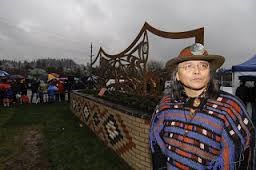Reconciliation takes shape in many forms. The Truth and Reconciliation Commission Report addresses its 94 Calls to Action primarily to federal and other levels of government to do right by Indigenous peoples in the areas of education, language, health and justice. But there is a lot we ordinary citizens can do.
Part of the focus of Knowing Our Place: A Reconciliation Initiative is to meet the Indigenous people on whose land we live, to get to know them, their culture, and their art. When you spend time with Indigenous people, you soon realize they have a very different view of the role of the artist in the community. The western idea of art as something you find in concert halls and galleries just doesn’t fit for cultures who use art to pass on teachings and stories.
The Squamish Nation has a rich artistic tradition, and has fostered many renowned artists in traditional arts such as drumming, dancing, singing; the carving of masks, canoes, welcome figures; painting, jewelry making; and the weaving of wool and cedar. Many of these art forms had been forgotten, lost, or banned through colonization, the Indian Act, and residential schools. Only in recent times, have they been reclaimed through the memories of Elders. For the Indigenous artist, singing and drumming and dancing are part of everyday life. Every meeting begins and ends with song. Scientific reason for that: music brings hearts and minds together so the meeting will be a fruitful one. You can expect lots of singing and drumming for the next event in Knowing Our Place: Building Bridges Through Art.
The bridge builders I have invited are all outstanding artists. Storyteller, Rebecca Campbell Duncan, whose ancestral name is Tsitsayxemaat, retells the stories of the Squamish people with a dramatic flair. I heard her at the Vancouver Public Library a year ago, and was captivated by her presence, and the way she brings ancient stories to life and makes them vivid, relevant, and inspiring to a contemporary audience. Once you’ve heard her tell the uplifting story of Ch’ich’iyuy, you will never look at the iconic mountain peaks, which we call the Lions, in the same way. Tsissayxemaat is also an accomplished weaver and I hope she will be wearing one of her beautifully woven cedar capes.
Squamish Nation Elder, Bob Baker, whose ancestral name is S7aplek, is the co-founder of Spawkwus Slulum, Eagle Song Dance Troupe. He has performed worldwide: in Montreux for the Summer Jazz Festival; in a cultural exchange with the Ainu of Hokkaido, Japan; in Hawai’i for cultural presentations; and in Whistler for the opening ceremonies at the 2010 Olympics. S7aplek is the Cultural Consultant for local schools, including BICS. He is also the person who brought back the seagoing canoe to his Nation after knowledge of these big powerful canoes had almost disappeared. S7aplek gives us an understanding of Squamish Nation culture through the teachings of the Longhouse, the seagoing canoe journeys, and the singing/drumming and dancing of his people.
Rick Harry (Xwalacktun) has been building bridges through his sculptures and carvings for over thirty years. Born and raised in Squamish, he was educated at Emily Carr and Capilano Colleges before he became an internationally recognized artist and cultural ambassador. He works in wood, glass, and steel, and is best known for his remarkable wood carvings that blend the traditional and the contemporary. His works have been commissioned by galleries in New York, New Hampshire, and many galleries in B.C. I first met Xwalacktun ten years ago at the unveiling of his monumental steel and brick sculpture, Spirit of the Mountain, at Ambleside Park. Like all his work, this sculpture is “a message keeper.” It offers a story of mutual respect between the communities of West Vancouver and the Squamish Nation as they journey together. The central themes in his art and his life are healing, growth, respect, and giving back to the community. For Xwalacktun, “All things grow and are healed by art.”
Come to The Gallery at Artisan Square for an interactive evening of Squamish Nation Art, Song, Dance, and Story. Friday, May 26 from 7:30-9:00 p.m. Free Admission thanks to sponsorship by First Credit Union. Donations are welcome.



